The system of feeding sailors used during the Napoleonic Wars persisted mostly unchanged until the late 19th century. Canning was first developed during those wars, and began to see widespread use in the middle of the century, somewhat improving the typical diet at sea. And while refrigeration went to sea in the 1880s, it was reserved exclusively for cargo. The men who ran the ships wouldn't be able to benefit from it for another decade. One early beneficiary was the cruiser Olympia, which commissioned with a steam-powered icemaker in 1895.
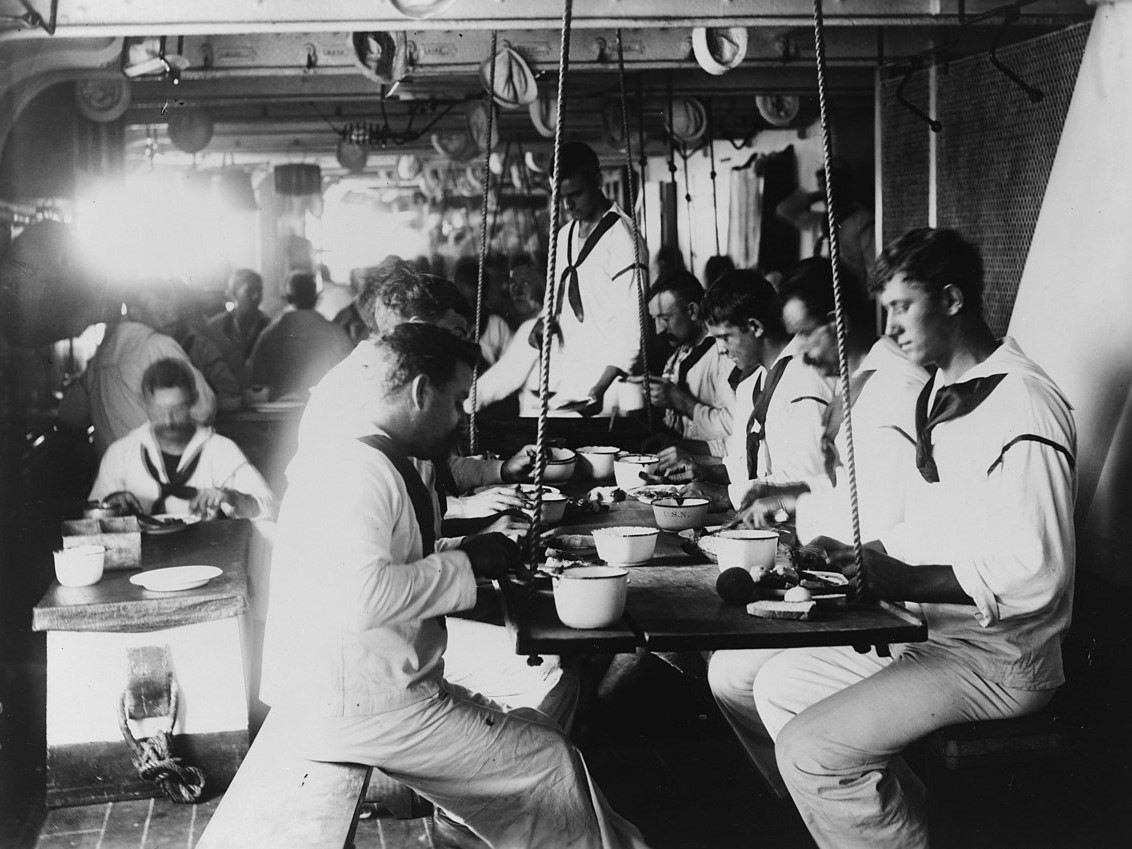
A crew mess aboard USS Olympia
By 1902, the USN had abandoned the traditional mess system in favor of the general mess, which centralized cooking under the ship's staff instead of each mess preparing food and bringing it to the galley to be cooked. This was an attempt to address many of the problems of the old "berth-deck mess", although the men were still divided into messes, who mostly ate in the same spaces they slept in. The mess manual from that year is interesting reading. Some of the points emphasized included that the general mess included every enlisted man except the chief petty officers and the officer's stewards,1 and that petty officers were to be broken up into different messes to remove the chance of favoritism. Any form of gratuity to the cooks is banned,2 and it is emphasized that the general mess is run by the Navy, and not by the men, and that the legal value of rations (30 cents a day) couldn't be drawn by the men and used to buy supplies for their own preparation. This was a common feature of the berth-deck messing system still used by the British, which issued rations almost unchanged from Nelson's day.
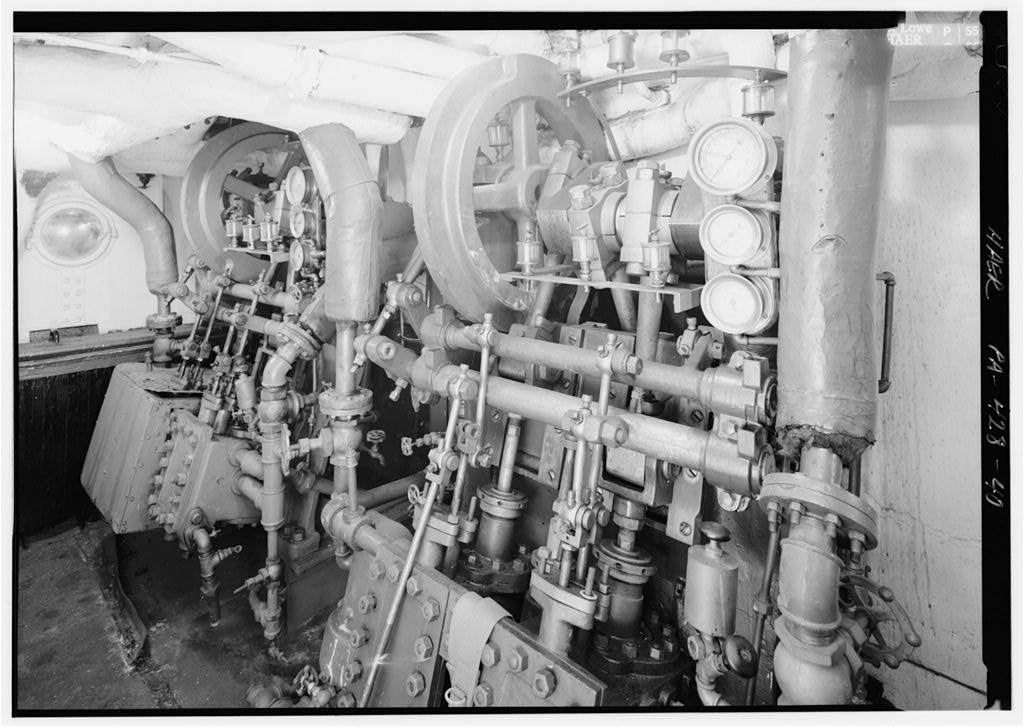
The refrigeration plan aboard Olympia
The berth-deck mess produced a healthy but monotonous diet, and most messes drew only some of their supplies this way, taking the rest as money to buy supplies from the onboard canteen. Even with a wider range of supplies, the lack of skill of each mess's cooks produced dissatisfaction. Thus, in 1907, the RN began adoption of general messing as well, although it was not applied to destroyers for many years. Only a few years before, Jackie Fisher had finally banished hardtack from the fleet, insisting that every ship have a bakery and produce fresh bread, as well as officially issuing sailors with eating utensils.3 Despite all of these changes, sailors still used the same spaces for eating and sleeping, lowering their mess tables and hanging their hammocks, as they had done for centuries.
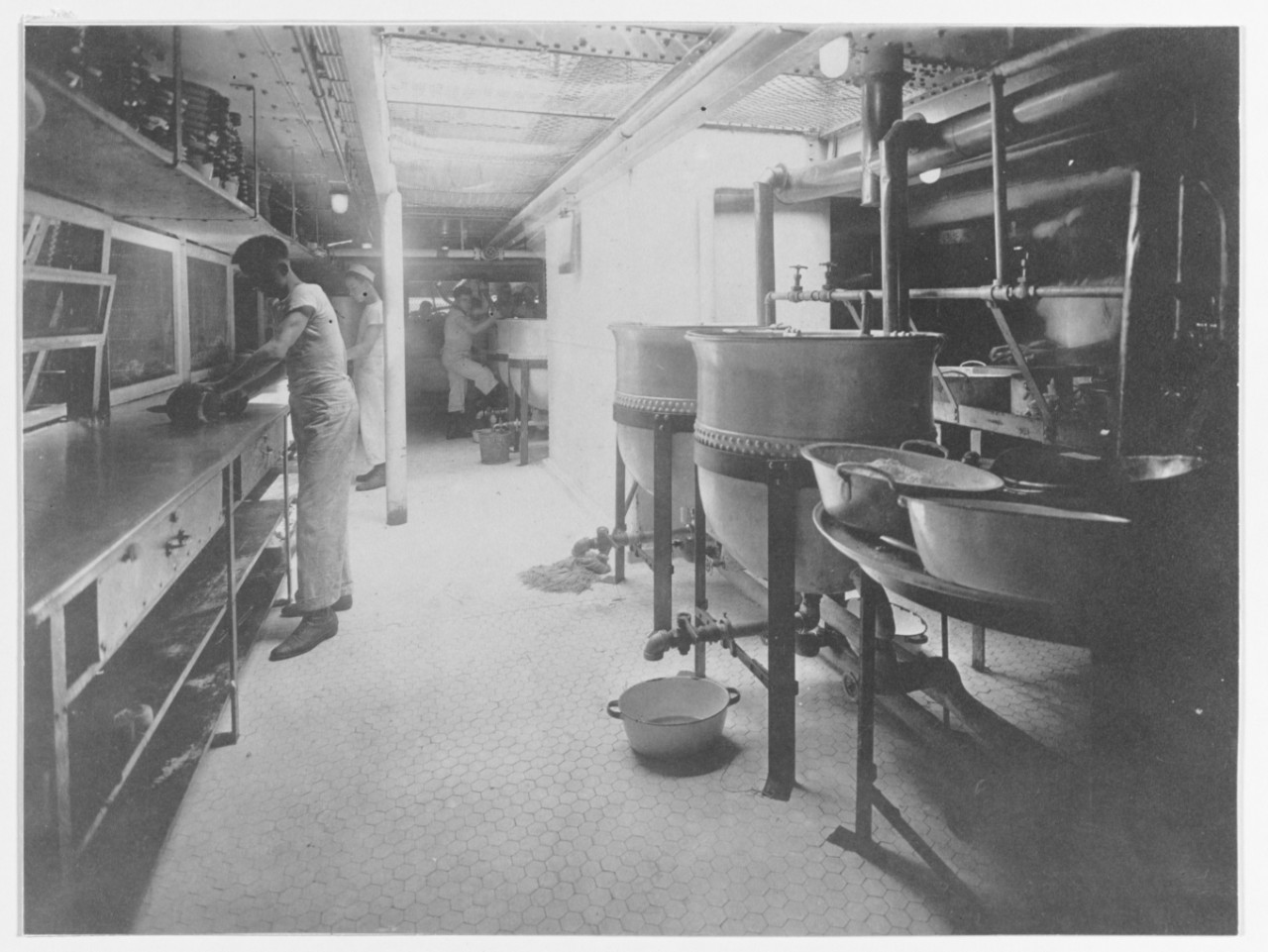
Cooking for the general mess aboard USS New Mexico, 1919
So what did the general mess serve? The 1902 USN manual provides a number of recipes, sized for 100 men and intended to form the basis for inexperienced cooks working with standard-issue rations. Most are fairly straightforward, with various forms of meat and basic vegetables boiled, fried or baked, and seasoned with salt and pepper. Most of the recipes use fresh meat and vegetables, instead of a focus on salted and canned versions. This isn't all due to refrigeration. Steam allowed much shorter and more reliable passages, so ships spent less time on long cruises at sea. The need to coal also contributed to more frequent resupply, and allowed the men of the steam navies to eat much better than their predecessors under sail had. Special meals would be laid on for events like Thanksgiving and Christmas. Many of these menus have been collected by Naval History and Heritage Command.
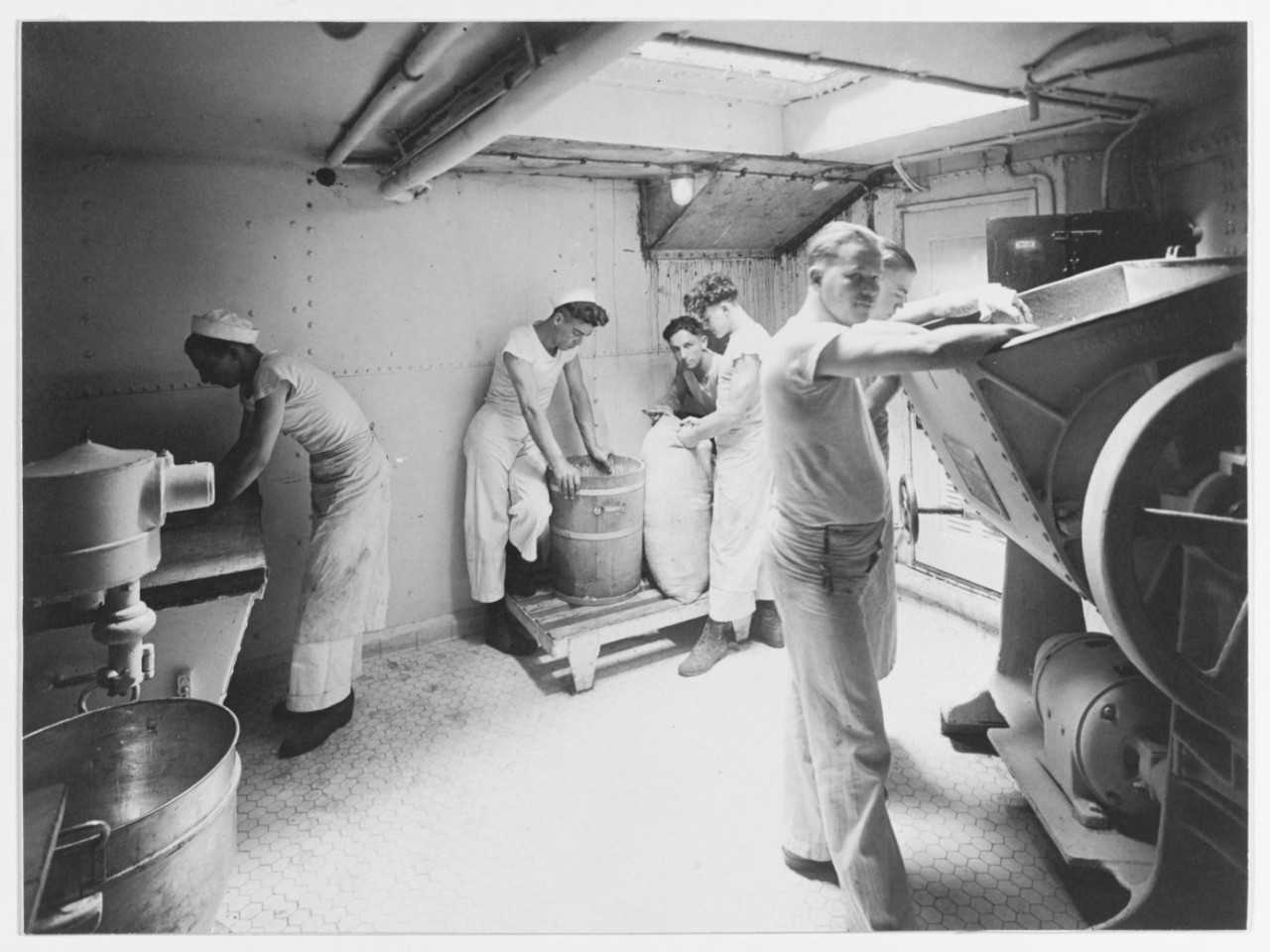
Baking aboard New Mexico, 1919
By 1920, things had gotten somewhat better. The USN's cooking school lasted 4 months, and was held at Newport, Rhode Island. The manual itself is four times the length of those at the turn of the century, with a much greater variety of recipes on offer, although it still provides precious little insight into how they were applied to actually feed the men. Western navies, as is typical, served three meals a day. In the RN of this era, breakfast was likely to be bacon, tinned tomatoes, bread, butter and tea, while lunch or dinner was likely to be a roast, with a pudding/duff for dessert.
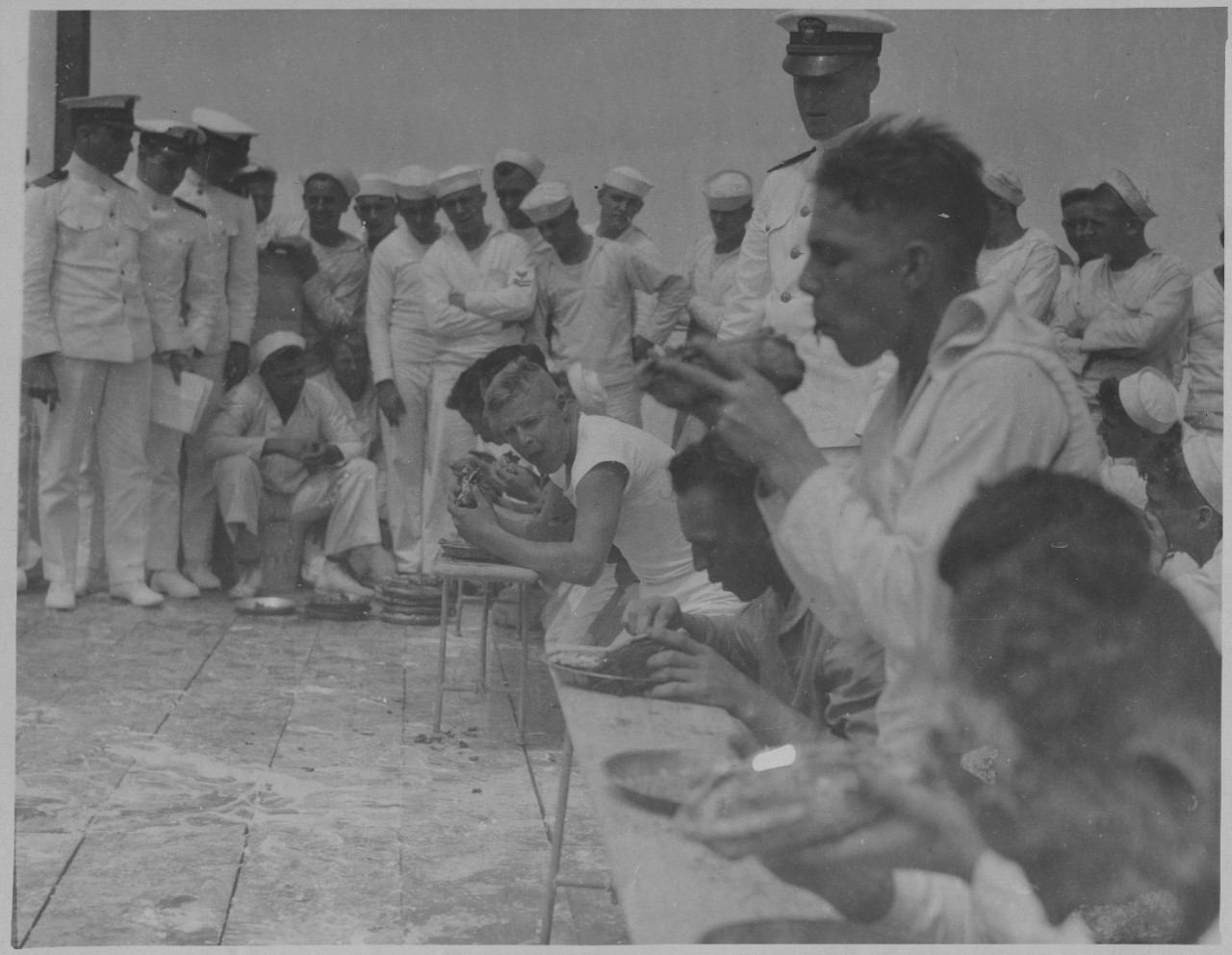
A more whimsical example of naval messing, a pie-eating contest aboard USS Maryland in the 1920s
Things continued to improve during the interwar years. The RN's 1936 Manual of Naval Cookery places a great deal of emphasis on technique in everything from carving of meat to visual presentation. It also has sections on spices and specialized tasks like small-group cooking and cooking for invalids, in addition to the 100-man large-group recipes that have been a staple of military cookbooks for over a century.4 It also describes a wide variety of equipment to aid the cooks, including things like potato chipping machines and steam chests, although these are alongside instructions for the use of coal-fired stoves.
These steps were largely matched in the USN, and even improved upon, particularly in the new ships commissioned after the outbreak of war. We'll take a look at how the sailors who fought around the globe were fed next time.
1 Traditionally, these were only kind of part of the Navy, as they were attached to their officers instead. ⇑
2 In practice, the "mess cook", responsible for fetching the meals for the mess, was still tipped through the 1920s and possibly later. Some sailors avoided promotion because they would lose their mess cook duties and take a significant pay cut. ⇑
3 This doesn't mean that the average sailor ate hardtack before Fisher, though. The Royal Navy Museum suggests that equipment for baking bread aboard ship became practical in the 1850s, and reading between the lines of various sources, I believe this was reasonably widespread before Fisher. It's mentioned by Massie and Marder, but ignored by both Bacon's and Mackay's biographies, as well as Lavery's Able Seamen. However, British destroyers didn't get their own bakeries until the A class in the late 20s. Before that, I believe they were supplied with bread by tenders or other support infrastructure. Fisher's contribution is mysterious, and nailing anything about this down has proven surprisingly difficult. ⇑

Comments
Fascinating!
The early age had the cooking duty rotating, so they were sailors with other duties that occasionally cooked. When navies switched to staff cooking, what did cooks do during battle? Did they have any additional duties?
They did. Warships, particularly in this age, took a lot of unskilled manpower in action. The cooks (and clerks and stewards and so on) might be ammunition passers or lookouts or talkers (on the sound-powered phone) or hose tenders on a damage control crew.
I'm curious about how warships managed (then and now) long periods at battle stations. Did the cooks periodically stand down and make everyone something to eat, or do they always store a few days' worth of sandwiches?
On mess tables: At least if Herman Melville's account of his time as an able seaman on USS United States in White-Jacket is to be believed, the USN in the 1840s didn't use mess tables, at least not for enlisted sailors who ate off a canvas square spread out on the deck.
The late 19th century is also when we get the interest in nutrition in the Imperial Japanese Navy- for interest, Takaki Kanehiro's experiments on preventing beriberi, or the IJN's adoption of curry as served in the RN (which then became popular with Japanese civilians, and still is).
Funny after asking this, I watched Greyhound, which should cooks helping transfer ammo!
(I really enjoyed the movie BTW!)
@AlexT
At some point, the captain will give orders for the cooks to go and get sandwiches and take them to the crew. There are different levels of readiness even at "Battle Stations" (Condition I), and one of them (Condition IE) is specifically to allow the cooks to get food and people to hit the head.
@AlphaGamma
Interesting. I'm surprised the USN would do that.
Browsing through an old Reddit thread, I found this info on British rations in the period 1677-1740: https://csphistorical.files.wordpress.com/2016/01/table-of-british-navy-food-rations1.jpg
Is there a post regarding General Quarters and the like on the way?
There might be. It's not written yet, but I have the stuff on hand, so it won't be hard.
Wikipedia says that the cruiser Olympia launched in 1892 but was commissioned in 1895. You have it commissioned in 1892. Which is correct?
Wiki is right, I am wrong. Will try to remember to fix when I get home.
I'm writing a biography of Admiral Sir Philip Vian, RN, for a publisher in the UK.
I've read volumes about the RN, but all of this is very fresh since I'm reading different books and re-reading old favourites. In WW2, a number of cooks and officers stewards in the British Mediterranean fleet were Maltese, Malta being the headquarters of the fleet (until it moved to Alexandria).
The Maltese often worked in the shell handling rooms during action stations. When the men needed to be fed, the bridge would order, "fall out cooks and stewards," or something similar, and those men would leave their positions in the shell handling rooms and prepare corned beef sandwiches and tea.
Usually, the shell handling rooms were over manned since men had to take a break when loading heavy shells into the hoists.